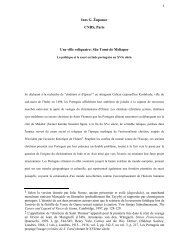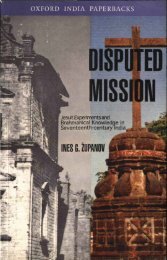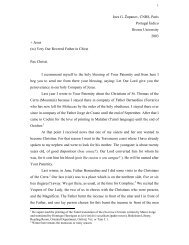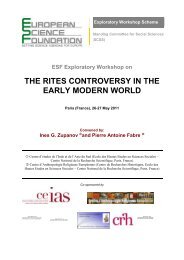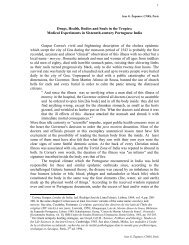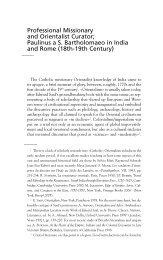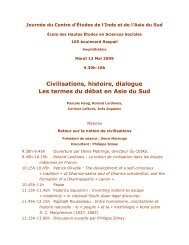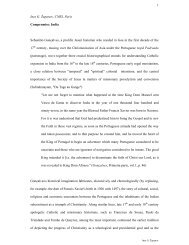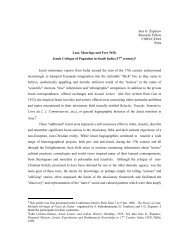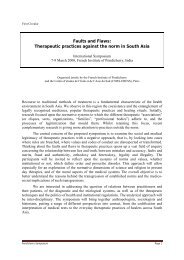Jesuit Orientalism; - Ines G. Županov
Jesuit Orientalism; - Ines G. Županov
Jesuit Orientalism; - Ines G. Županov
Create successful ePaper yourself
Turn your PDF publications into a flip-book with our unique Google optimized e-Paper software.
16<br />
corruptions were usually attributed to the work of the Devil and to the “perfidy” of the<br />
Brahmans. This kind of approach, based on a neo-scholastic Aristotelian grid, led to a<br />
permanent mistrust of indigenous texts. Even those <strong>Jesuit</strong>s who were Orientalist in the<br />
primary meaning of the word, that is, those who were proficient in Asian languages used more<br />
often their erudition and analysis to refute concepts and meanings rather than to explain them.<br />
The wealth of accumulated knowledge, however, enabled the <strong>Jesuit</strong> writers to compare<br />
and collate data, even when they were dismissed as unreliable. Queiros‟s wobbly description<br />
of Sri Lankan heathenism is full of fictitious renditions of myths and events, and yet, at least<br />
in fragments, we can identify religious practices attested by anthropologists and contemporary<br />
students of Sri Lankan culture. Queiros‟s most important “ethnographic” achievement is his<br />
effort at piecing together the origin, the diffusion and the founding myths of what he calls the<br />
“sect of Buddum”. Just because Buddhism was propelled, after Orientalist scholars<br />
watermarked its “authentic” textual sources in the 19 th century, into the category of a “world”<br />
religion, it is quite erroneous to say that “Buddhism had only recently [early 19 th c.] been<br />
recognized as „the same‟ tradition existing in diverse regions of South, Southeast, East and<br />
Central Asia”. 46 Queiros knew well that Buddhism was a transnational “sect”, extending over<br />
most of the known Asian countries. 47<br />
“And it has been observed that the Ganêzes of Ceylon, the Talpoys of Arracan, Pegu, Siam<br />
and other neighboring Realms, as well as the Lamazes of Tartry agree with the Bonzes of<br />
China and Japan in the essentials of their sect and profession, it is easy to understand that the<br />
Buddum of Ceylon, the Fô of Kina, the Xaka of Japan is the same as the Xekia of India, for<br />
the word Buddum is only an adapted name, and in the Ceylon it means Saint by<br />
antonomasia.” 48<br />
Buddhism was, in fact, quite early identified as a particular sect with relatively well defined<br />
founder that seemed to have migrated from the west into China and then to Japan. This is the<br />
story told by Anjiro, Francis Xavier‟s first Japanese convert whose summary description of<br />
Buddhism made it into Nicolò Lancilotto‟s report, used widely by Guillome Postel in Des<br />
46 Tomako, Masuzawa,The Invention of World Religions, Chicago and London: Chicago<br />
University Press, 2005, p. 122.<br />
47 Queiros, pp. 89-90.<br />
48 Queiros, p. 110.




